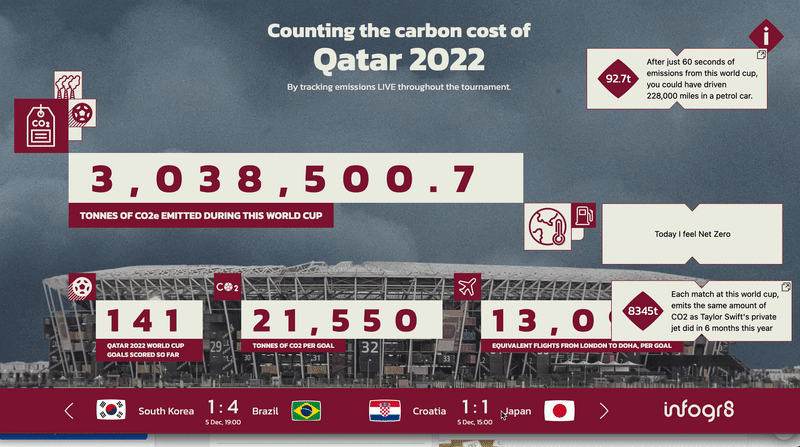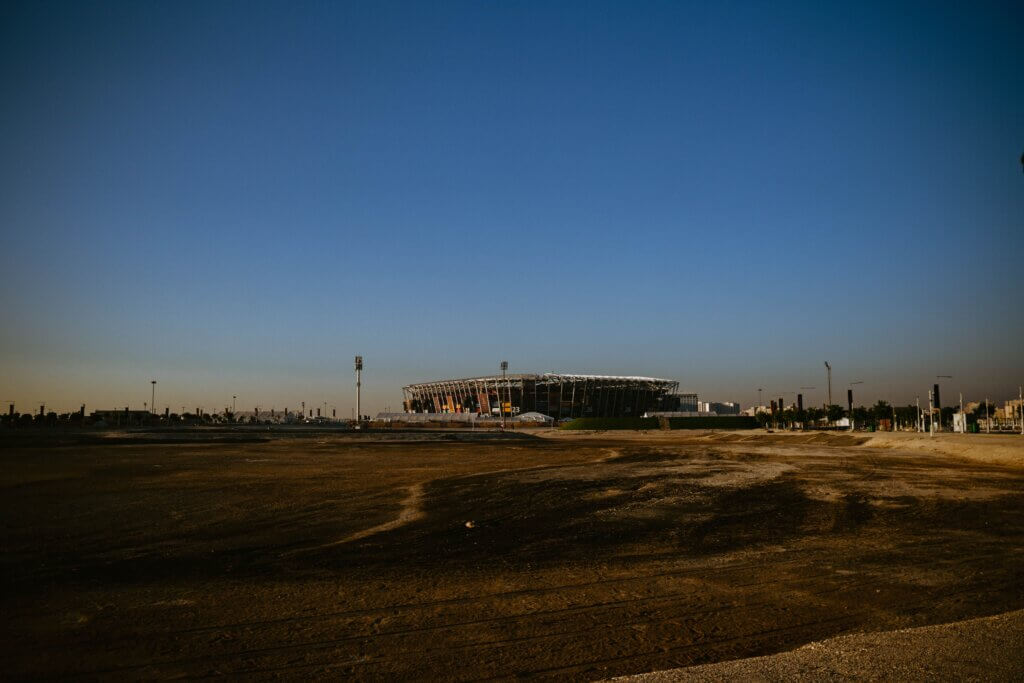 Insight How we’re tracking FIFA’s ‘net zero World Cup’ claims, one goal at a time
Insight How we’re tracking FIFA’s ‘net zero World Cup’ claims, one goal at a time

The World Cup is a big deal, and not just for football fans. It’s a cultural waypoint that bears its mark on the lives of all those interested in sport, and probably quite a lot of people who aren’t even that bothered, too. For the final last time out (in Russia, no less), 1.2 billion people watched the showpiece event.
In fact, World Cups are such an important cultural marker that they can be used as a measurement of time. A former colleague of mine once referred to humanity having “two World Cups” left before we run out of time to prevent irreparable climate damage.
While it might be 68 years of hurt for England fans by the time 2034 arrives, the more important hurt is the condition that the planet will be in by that time. How different will our lives be due to the effects of climate change? And that’s only three World Cups away.
So for this World Cup, while much of the focus has been on Qatar’s approach to human rights, labour laws, and the LGBTQ community – and rightly so – at infogr8 we felt it would be remiss of us to allow the carbon impact of this World Cup to go completely under the radar. FIFA and Qatar have been downplaying emissions at every turn and using false calculations to produce their estimated emissions, along with highly questionable offsets.

Photo by Matthew Yamamoto on Unsplash
In sustainability circles, we often talk about carbon intensity, and what better measure of carbon intensity for the World Cup than CO2 per goal scored? We were inspired by analysis by the excellent Eco Experts, who estimate that this World Cup will emit a shade over 4.6 million tonnes of CO2. We combined this figure with a live-scores API feed sourced from the web to create our calculation, adding in an animated counter to show the emissions ratcheting up every second for dramatic effect.
At infogr8, our promise is to Make Data for Everyone. We believe that creating data-led visual experiences is the most effective way to increase understanding among audiences of all shapes and sizes. When done right, data empowers people to take action – for the benefit of themselves, for their communities, and for society as a whole. As this piece by Cameron Fadjo at Data Stories highlights, “global change is most effective at the local level”, so instead of creating a really complex data dashboard or tool, our aim was to keep it simple and shareable, so that it could resonate with as many people as possible while giving everyone the opportunity to learn more.
The team drew on our experience and expertise in creating impactful data stories. We rapidly developed the front-end for our data broadcast using the leading-edge data visualisation toolkits Svelte and Tailwind. The design was intended to be as minimal as possible, to grab the attention of the audience with top-line figures that stick in the memory, and to provide instant understanding and shock value. We wanted to bring meaning to the data in a fast and exciting way, provoking the question “Is the carbon cost of this World Cup really worth it?”
World Cup Emissions Goal Tracker

Photo by Fasyah Halim on Unsplash
This data-driven message is emphatically rammed home, like a Lionel Messi penalty, by providing additional context. In this case, we decided to calculate the carbon equivalent of return flights from Doha to London Heathrow. This shows the scale of the emissions in a way that is instantly relatable and understandable: each goal in this World Cup has the carbon cost equivalent of around 13,000 passenger return flights.
Data storytelling is what we do best, so if you’re looking to land impact, whether that’s internally to make quicker, better, more data-driven decisions, or externally to communicate key messages to consumers, investors or other interested parties, book in a call with me and we can talk sustainability, data, and football (if you really want to).
And just to clarify, we really do love football. We love the World Cup and we still love Harry Kane. This is not about being the “woke brigade”, the “fun police” or “crusty eco warriors” – it’s about expecting better. The World Cup is such an important cultural yardstick on every continent, and that gives it the potential to be a beacon of hope – an example of how to run genuinely green (or greener) global events. In sustainability terms, this World Cup has been a disappointment at every possible turn. So if FIFA over-promise and under-deliver again in 2026, we’ll be waiting.
Are you looking to learn more about how visualising your data can provide positive impact on sustainability?
I want to hear more from Stewart
